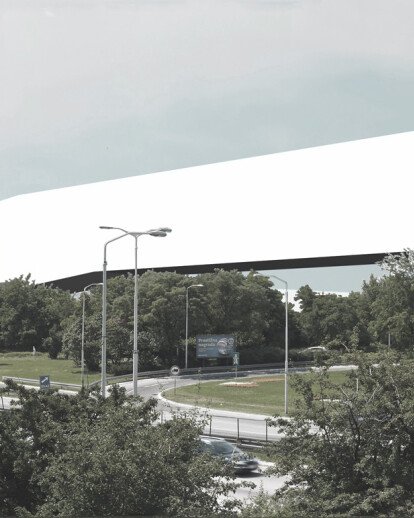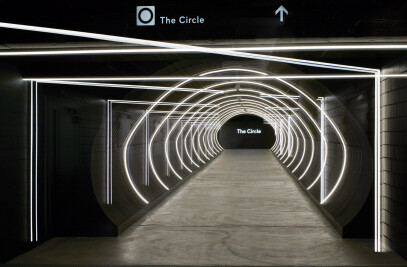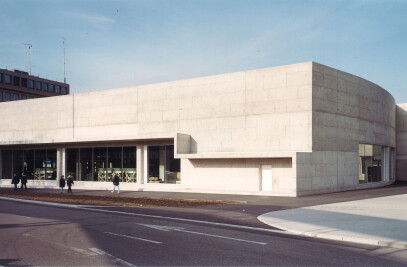New Belgrade, the individual blocks and the buildings constitute a conceptual and artistic whole. All of the system parts are arranged with the greatest possible rationality, clarity and well-conceived organization along the lines of a unified structural system. This system gives New Belgrade a distinctive manifestation, and integrates the individual blocks and building into the overall concept. Urban Development. The urban plan of New Belgrade is based on a rectangular grid, which in turn defines individual rectangular building segments. The original core area of the city, consisting of nine segments, has grown several times larger over the years in accordance with the basic idea. In formal terms, the various blocks of the city are developed very differently. Block39. The pattern of urban development for the planned Scientific Research Institute defines the block on the length the streets. In the corner areas the building is raised above ground level, giving an uninterrupted view into the middle of the park with the planned Center for the Promotion of Science in the center point. Park. The design of the park consists of a series of spacious rectangular plots with tree populations, in which the new buildings, a tower block for the Research Center, the Center for the Promotion of Science and the existing school of art are embedded. The rectangular expanses are covered with lawns and planted with trees. The existing trees are integrated into the overall concept wherever possible. Center for the Promotion of Science. The new one-storey, flat building stands independently in the park beneath the trees. The basic rectangular form of the rational and restrained external appearance of the building relates to the spaciousness of the overall urban development concept. The design dispenses with cheap technical gestures, and instead works with the timeless elements of space, volume, light and the succession of routes. This creates a distinguished and unobtrusive framework for the scientific exhibition. Architecture. Externally the appearance of the building is deliberately simple and restrained, but rich in structural and interior spatial design. A wide variety of routes, clear spatial relations, unexpected views out of and into the building, and indirect incoming light via the courtyards and skylights make for a beautiful and restrained building. It forms the composed backdrop for various exhibitions and events. Organization. The building is organized into four functional zones (exhibition, service, planetarium, auditorium) with three hallways running between them. The outer passageway along the façade provides access to all the rooms and routes, and visually connects them with the park. A spacious foyer forms itself in front of the auditorium and the planetarium, lighted via the adjoining courtyards. At the basement level a hallway joins the indoor parking and the service facility spaces with the building. Section. The urban perimeter block development of the Research Center rises in height at the corners, whereas the exhibition building is organized from the top downwards. The interior spaces of the exhibition building form a counter-movement, whereby the stairs and ramps lead downwards to the various functions. Double-storey spaces are created for the exhibitions, the planetarium and the auditorium. Courtyards and skylights illuminate the depth of the rooms. Accessibility, Outer Passageway. In summer the building is accessible from all sides. It becomes a part of the park. In winter there are fewer entrances, conceived of as sluices. Construction, Material. The building consists of a ground floor and a basement level. The four cores are formed as load bearing elements. The roof of the outer passageway is cantilevered outwards on all sides so that edge columns are not necessary. The façade appears light and transparent. The outer passageway space belongs simultaneously to both the exhibition building and the park. The construction consists of reinforced concrete; the walls, floors and stairs are covered with a light stone; the ceilings are plastered white. The choice of calm materials contrasts with the movement and the distribution of light. The exhibition and event spaces are designed using technical materials. They form a reference to the exhibited objects. Transitional Layer, Climate Barrier. The outer passageway encompasses the inner cores and serves to provide access to the individual functions. This multifunctional space is simultaneously the foyer, access, exhibition, auditorium, promenade and café. The space is not heated, and serves in summer and winter as a climate barrier between inside and outside. The intermediate climate created allows all year round use. Access. Access, deliveries and the vehicle parking are arranged out of sight in the basement level. Horizontal and vertical connections lead to the exhibition building. Sustainability. The outer passageway is conceived as a climate barrier and isolates the core of the building in the summer-winter cycle. The heating and cooling energy is generated from the earth by means of a heat pump. Solar panels are mounted on the roof. The massive building structure can store warmth and enables a balanced and comfortable climate using little energy. Idea. New Belgrade, the individual blocks and the buildings constitute a conceptual and artistic whole. All of the system parts are arranged with the greatest possible rationality, clarity and well-conceived organization along the lines of a unified structural system. This system gives New Belgrade a distinctive manifestation, and integrates the individual blocks and building into the overall concept. Urban Development. The urban plan of New Belgrade is based on a rectangular grid, which in turn defines individual rectangular building segments. The original core area of the city, consisting of nine segments, has grown several times larger over the years in accordance with the basic idea. In formal terms, the various blocks of the city are developed very differently. Block39. The pattern of urban development for the planned Scientific Research Institute defines the block on the length the streets. In the corner areas the building is raised above ground level, giving an uninterrupted view into the middle of the park with the planned Center for the Promotion of Science in the center point. Park. The design of the park consists of a series of spacious rectangular plots with tree populations, in which the new buildings, a tower block for the Research Center, the Center for the Promotion of Science and the existing school of art are embedded. The rectangular expanses are covered with lawns and planted with trees. The existing trees are integrated into the overall concept wherever possible. Center for the Promotion of Science. The new one-storey, flat building stands independently in the park beneath the trees. The basic rectangular form of the rational and restrained external appearance of the building relates to the spaciousness of the overall urban development concept. The design dispenses with cheap technical gestures, and instead works with the timeless elements of space, volume, light and the succession of routes. This creates a distinguished and unobtrusive framework for the scientific exhibition. Architecture. Externally the appearance of the building is deliberately simple and restrained, but rich in structural and interior spatial design. A wide variety of routes, clear spatial relations, unexpected views out of and into the building, and indirect incoming light via the courtyards and skylights make for a beautiful and restrained building. It forms the composed backdrop for various exhibitions and events. Organization. The building is organized into four functional zones (exhibition, service, planetarium, auditorium) with three hallways running between them. The outer passageway along the façade provides access to all the rooms and routes, and visually connects them with the park. A spacious foyer forms itself in front of the auditorium and the planetarium, lighted via the adjoining courtyards. At the basement level a hallway joins the indoor parking and the service facility spaces with the building. Section. The urban perimeter block development of the Research Center rises in height at the corners, whereas the exhibition building is organized from the top downwards. The interior spaces of the exhibition building form a counter-movement, whereby the stairs and ramps lead downwards to the various functions. Double-storey spaces are created for the exhibitions, the planetarium and the auditorium. Courtyards and skylights illuminate the depth of the rooms. Accessibility, Outer Passageway. In summer the building is accessible from all sides. It becomes a part of the park. In winter there are fewer entrances, conceived of as sluices. Construction, Material. The building consists of a ground floor and a basement level. The four cores are formed as load bearing elements. The roof of the outer passageway is cantilevered outwards on all sides so that edge columns are not necessary. The façade appears light and transparent. The outer passageway space belongs simultaneously to both the exhibition building and the park. The construction consists of reinforced concrete; the walls, floors and stairs are covered with a light stone; the ceilings are plastered white. The choice of calm materials contrasts with the movement and the distribution of light. The exhibition and event spaces are designed using technical materials. They form a reference to the exhibited objects. Transitional Layer, Climate Barrier. The outer passageway encompasses the inner cores and serves to provide access to the individual functions. This multifunctional space is simultaneously the foyer, access, exhibition, auditorium, promenade and café. The space is not heated, and serves in summer and winter as a climate barrier between inside and outside. The intermediate climate created allows all year round use. Access. Access, deliveries and the vehicle parking are arranged out of sight in the basement level. Horizontal and vertical connections lead to the exhibition building. Sustainability. The outer passageway is conceived as a climate barrier and isolates the core of the building in the summer-winter cycle. The heating and cooling energy is generated from the earth by means of a heat pump. Solar panels are mounted on the roof. The massive building structure can store warmth and enables a balanced and comfortable climate using little energy.
More Projects by Dürig AG
Products Behind Projects
Product Spotlight
News

Introducing Partner Geopietra
Geopietra® is an international brand and an Italian company founded in 1996, specialized in the... More

Shigeru Ban’s Paper Log House at Philip Johnson’s Glass House
In New Canaan, Connecticut, Shigeru Ban: The Paper Log House has opened as part of the 75th annivers... More

10 commercial buildings that benefit from planted facades
The integration of nature into architecture marks a proactive urban response to the climate emergenc... More

Hudson Valley Residence by HGX Design draws inspiration from local agricultural vernacular
New York City-based creative studio HGX Design has completed the Hudson Valley Residence, a modern,... More

Key projects by Perkins&Will
Perkins&Will, a global interdisciplinary design practice, places architecture at its core. With... More

Archello Awards 2024 – Early Bird submissions ending April 30th
The Archello Awards is an exhilarating and affordable global awards program celebrating the best arc... More

Albion Stone creates stone bricks from “unloved” stone
A stone brick is a sustainable building material made using stone blocks and slabs that do not meet... More

25 best engineered wood flooring manufacturers
Engineered wood flooring is a versatile building product that offers several advantages over traditi... More

























